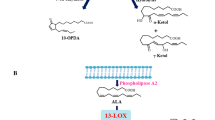Abstract
Oleosomes, up to 14μm in diameter, were found in mesophyll and bundle sheath cells of the flag and lower leaves of wheat cv Professeur Marchal. They develop in flag leaves at least 10 d before anthesis, possibly from fatty acids secreted by the plastids, and persist in mature and senescing leaf tissue. Oleosomes are bordered with an osmiophilic layer rather than a unit membrane. The major lipids of oleosomes, isolated 20 d after anthesis, are triacylglycerols (50%) and sterol or wax exter (34%). The dominant fatty acids of both lipid classes are plamitic (16:0) and stearic (18:0) acids which accounts for the low osmiophilia of the oleosomes. The function of the oleosomes is unknown but they may act as short-term energy reserves. Oleosomes persist in leaves infected with brown rust, even in cells penetrated by haustoria. Yellowish-brown oleosomes found in senescing and rust-infected leaves may be formed by the release and coalescence of pigmented plastoglobuli.
Similar content being viewed by others
References
Appelqvist, L.-A. (1975) Biochemical and structural aspectsof storage and membrane lipids in developing oil seeds. In: Recent advances in the chemistry and biochemistry of plant lipids. pp. 247–286. Galliard, T., Mercer, E.I., eds. Academic Press, London New York San Francisco
Austin, R.B., Edrich, J.A., Ford, M.A., Blackwell, R.D. (1977) The fate of the dry matter, carbohydrates and 14C lost from the leaves and stems of wheat during grain filling. Ann. Bot. 41, 1309–1321
Bergfeld, R., Hong, Y.-N., Kühnl, T., Schopfer, P. (1978) Formation of oleosomes (storage lipid bodies) during embryogenesis and their breakdown during seedling development in cotyledons of Sinapis alba L. Planta 143, 297–307
Bligh, E.G., Dyer, W.J. (1959) A rapid method of total lipid extraction and purification. Can. J. Biochem. Physiol. 37, 911–917
Body, D.R. (1974) Neutral lipids of leaves and stems of Trifolium repens. Phytochemistry 13, 1527–1530
Green, T.G., Hilditch, T.P., Stainsby, W.J. (1936) The seed wax of Simmondsia californica. J. Chem. Soc., 1750–1755
Harwood, J.L. (1975) Fatty acid biosynthesis. In: Recent advances in the chemistry and biochemistry of plant lipids, pp. 43–93. Galliard, T., Mercer, E.I., eds. Academic Press, London New York San Francisco
Kartha, A.R.S., Singh, S.P. (1969) The in vivo ‘quantum’ synthesis of reserve waxes in seeds of Murraya koenigii (Linn.) Spreng. Chem. Ind., 1342–1343
Kharbush, S. (1926) Recherches cytologiques sur les blés parasités par Puccinia glumarum. Rev. Pathol. Vég. Entomol. Agric. Fr. 13, 92–110
Kleinig, H., Steinki, C., Kopp, C., Zaar, K. (1978) Oleosomes (spherosomes) from Daucus carota suspension culture cells. Planta 140, 233–237
Lösel, D.M. (1978) Lipid metabolism of leaves of Poa pratensis during infection by Puccinia poarum. New Phytol. 80, 167–174
Morrison, W.R., Tan, S.L., Hargin, K.D. (1980) Methods for the quantitative analysis of lipids in cereal grains and similar tissues. J. Sci. Fd Agric. 31, 329–340
Rosenberg, A. (1967) Euglena gracilis: a novel lipid energy reserve and arachidonic acid enrichment during fasting. Science 157, 1189–1191
Schmidt, E.W. (1932) Über eine pathologische Fettbildung im Zuckerrübenblatt. Ber. Dtsch. Bot. Ges. 50, 472–474
Shand, J.H., Noble, R.C. (1980) Quantification of lipid mass by a liquid scintillation counting procedure following charring on thin layer plates. Anal. Biochem. 101, 427–434
Skipski, V.P., Smolowe, A.F., Sullivan, R.C., Barclay, M. (1965) Separation of lipid classes by thin-layer chromatography. Biochim. Biophys. Acta 106, 386–396
Sridhar, R., Buddenhagen, I.W., Ou, S.H. (1973) Presence of lipid bodies in rice leaves and their discolouration during pathogenesis. Experientia 29, 959–960
Thatcher, F.S. (1943) Cellular changes in relation to rust resistance. Can. J. Res. 21, 151–172
Wardlaw, I.F., Porter, H.K. (1967) The redistribution of stem sugars in wheat during grain development. Aust. J. Biol. Sci. 20, 309–318
Yatsu, L.Y., Jacks, T.J., Hensarling, T.P. (1971) Isolation of spherosomes (oleosomes) from onion, cabbage, and cottonseed tissues. Plant Physiol. 48, 675–682
Author information
Authors and Affiliations
Rights and permissions
About this article
Cite this article
Parker, M.L., Murphy, G.J.P. Oleosomes in flag leaves of wheat; their distribution, composition and fate during senesence and rust-infection. Planta 152, 36–43 (1981). https://doi.org/10.1007/BF00384982
Received:
Accepted:
Issue Date:
DOI: https://doi.org/10.1007/BF00384982




